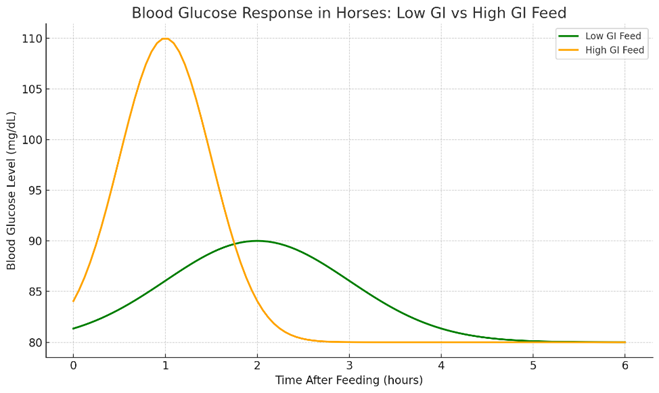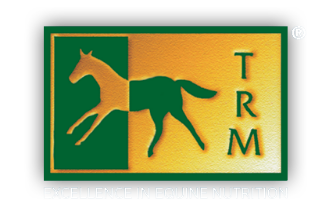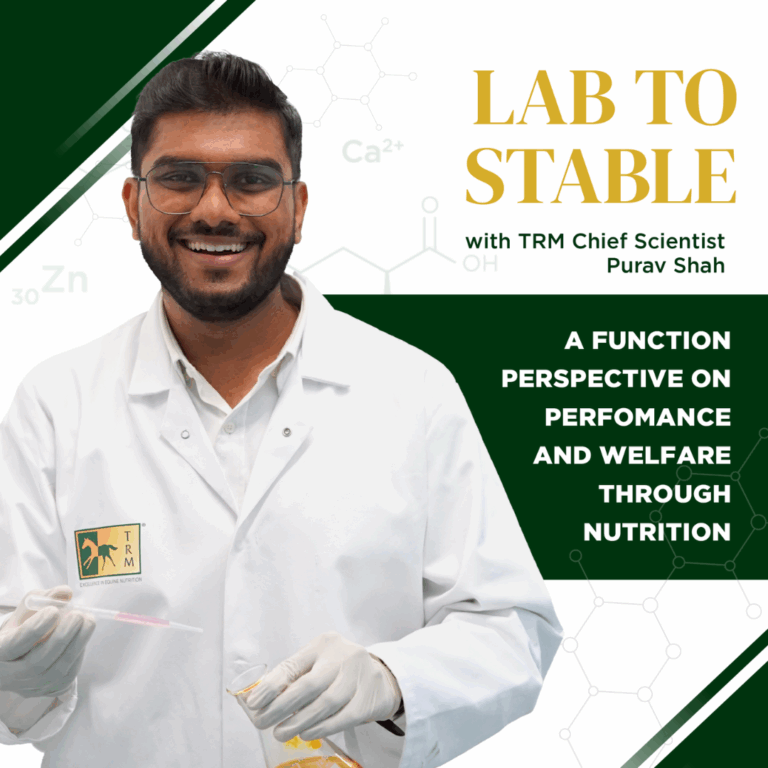
Fuelling Horses Smarter: How Low-Glycaemic Index (GI) Ingredients Support Sustained Energy
By TRM Chief Scientific Officer Purav Shah (M.Sc. (Hons), B. Pharm)
When it comes to performance and endurance, horses are remarkable athletes. But like human athletes, they require the right fuel to perform at their best. A growing body of equine nutrition science suggests that low GI ingredients may hold the key to sustained energy, better metabolic health, and improved performance—especially for sport horses, endurance competitors, and metabolically sensitive breeds. This article explores the physiological basis for low-GI feeding in horses and its practical applications.
Understanding Glycaemic Index in Equine Diets
The GI measures how quickly carbohydrates in a feed raise blood glucose after ingestion. High-GI feeds like cereal grains (e.g., corn, oats) are rapidly digested in the small intestine, causing sharp spikes in blood glucose and insulin. While useful for quick energy, they can lead to energy crashes, erratic behaviour, and metabolic stress.
Low-GI feeds—such as beet pulp, soybean hulls, and certain forages—digest more slowly, supporting steady glucose release, sustained energy, improved focus, and reduced metabolic disruption.
Fig. 1: A graph illustrating the difference in typical blood glucose response in horses after consuming low glycaemic index (GI) versus high GI feed.
While the GI is a well-established concept in human nutrition, its application in equine diets is gaining recognition due to its relevance in managing energy delivery, metabolic health, and certain disease conditions.

Energy Metabolism and Performance Benefits of Low-GI Feeding in Horses
In horses, energy is primarily derived from volatile fatty acids (VFAs) produced by hindgut fermentation and glucose absorbed in the small intestine. High GI feeds lead to rapid spikes in blood glucose and insulin, promoting glycogen synthesis but potentially contributing to insulin resistance, particularly in sedentary or metabolically sensitive horses.
Low-GI ingredients provide a slower, sustained release of glucose, supporting stable insulin dynamics and reducing the risk of metabolic disorders like equine metabolic syndrome (EMS) and laminitis. In performance horses, this steady energy availability aligns with the demands of endurance, racing and eventing disciplines by improving substrate utilization and reducing reliance on lactate-producing anaerobic glycolysis, thereby delaying fatigue and enhancing muscle efficiency.
Moreover, low-GI diets may help minimize behavioural issues and digestive disturbances commonly associated with high-starch feeds, particularly in confined or lightly exercised horses.

Examples of Low-GI Feed Ingredients
Several feedstuffs commonly used in equine rations have low GI, including:
- Beet pulp (soaked, molasses-free): High in fermentable fibre, supports hindgut fermentation.
- Soy hulls: A by-product high in digestible fibre and low in starch.
- Timothy and alfalfa hay: Low natural GI when not contaminated with excessive non-structural carbohydrates (NSC).
- Oil sources (e.g., canola, flaxseed oil): Provide non-carbohydrate energy, reducing glycaemic load.
It’s important to carefully select not only low-GI feed ingredients but also complementary low-GI feed supplements, to ensure the diet consistently supports stable blood glucose levels.
Conclusion
The strategic use of low GI ingredients in equine diets offers multiple benefits, from stabilizing blood glucose and insulin responses to enhancing metabolic efficiency and performance. As equine practitioners and nutritionists seek to optimize feeding programs, particularly for metabolically challenged or high-performance horses, incorporating low-GI feed supplements provides a scientifically sound approach to fuelling horses smarter.
To support sustained energy and enhance oxygen delivery, without spiking glucose or insulin, discover TRM’s IronXcell— a liquid iron and B‑vitamin tonic on a Sorbitol base (very low GI of 4-9) designed as a complementary feed for performance and sport horses.

Missed last week’s article on Equine Mobility? Read it here!
Follow @TRMNutrition on social media:



